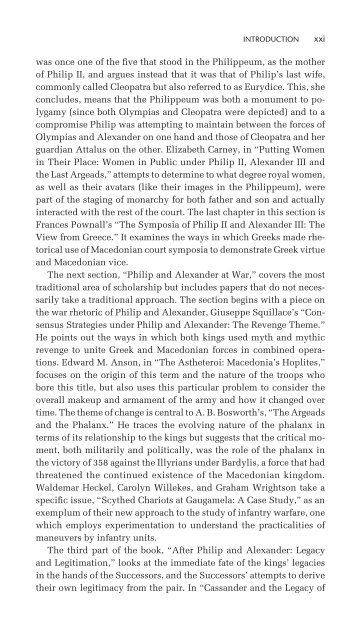Philip II and Alexander the Great: Father and Son ... - Historia Antigua
Philip II and Alexander the Great: Father and Son ... - Historia Antigua
Philip II and Alexander the Great: Father and Son ... - Historia Antigua
Create successful ePaper yourself
Turn your PDF publications into a flip-book with our unique Google optimized e-Paper software.
INTRODUCTION xxi<br />
was once one of <strong>the</strong> fi ve that stood in <strong>the</strong> <strong>Philip</strong>peum, as <strong>the</strong> mo<strong>the</strong>r<br />
of <strong>Philip</strong> <strong>II</strong>, <strong>and</strong> argues instead that it was that of <strong>Philip</strong>’s last wife,<br />
commonly called Cleopatra but also referred to as Eurydice. This, she<br />
concludes, means that <strong>the</strong> <strong>Philip</strong>peum was both a monument to polygamy<br />
(since both Olympias <strong>and</strong> Cleopatra were depicted) <strong>and</strong> to a<br />
compromise <strong>Philip</strong> was attempting to maintain between <strong>the</strong> forces of<br />
Olympias <strong>and</strong> Alex<strong>and</strong>er on one h<strong>and</strong> <strong>and</strong> those of Cleopatra <strong>and</strong> her<br />
guardian Attalus on <strong>the</strong> o<strong>the</strong>r. Elizabeth Carney, in “Putting Women<br />
in Their Place: Women in Public under <strong>Philip</strong> <strong>II</strong>, Alex<strong>and</strong>er <strong>II</strong>I <strong>and</strong><br />
<strong>the</strong> Last Argeads,” attempts to determine to what degree royal women,<br />
as well as <strong>the</strong>ir avatars (like <strong>the</strong>ir images in <strong>the</strong> <strong>Philip</strong>peum), were<br />
part of <strong>the</strong> staging of monarchy for both fa<strong>the</strong>r <strong>and</strong> son <strong>and</strong> actually<br />
interacted with <strong>the</strong> rest of <strong>the</strong> court. The last chapter in this section is<br />
Frances Pownall’s “The Symposia of <strong>Philip</strong> <strong>II</strong> <strong>and</strong> Alex<strong>and</strong>er <strong>II</strong>I: The<br />
View from Greece.” It examines <strong>the</strong> ways in which Greeks made rhetorical<br />
use of Macedonian court symposia to demonstrate Greek virtue<br />
<strong>and</strong> Macedonian vice.<br />
The next section, “<strong>Philip</strong> <strong>and</strong> Alex<strong>and</strong>er at War,” covers <strong>the</strong> most<br />
traditional area of scholarship but includes papers that do not necessarily<br />
take a traditional approach. The section begins with a piece on<br />
<strong>the</strong> war rhetoric of <strong>Philip</strong> <strong>and</strong> Alex<strong>and</strong>er, Giuseppe Squillace’s “Consensus<br />
Strategies under <strong>Philip</strong> <strong>and</strong> Alex<strong>and</strong>er: The Revenge Theme.”<br />
He points out <strong>the</strong> ways in which both kings used myth <strong>and</strong> mythic<br />
revenge to unite Greek <strong>and</strong> Macedonian forces in combined operations.<br />
Edward M. Anson, in “The As<strong>the</strong>teroi: Macedonia’s Hoplites,”<br />
focuses on <strong>the</strong> origin of this term <strong>and</strong> <strong>the</strong> nature of <strong>the</strong> troops who<br />
bore this title, but also uses this particular problem to consider <strong>the</strong><br />
overall makeup <strong>and</strong> armament of <strong>the</strong> army <strong>and</strong> how it changed over<br />
time. The <strong>the</strong>me of change is central to A. B. Bosworth’s, “The Argeads<br />
<strong>and</strong> <strong>the</strong> Phalanx.” He traces <strong>the</strong> evolving nature of <strong>the</strong> phalanx in<br />
terms of its relationship to <strong>the</strong> kings but suggests that <strong>the</strong> critical moment,<br />
both militarily <strong>and</strong> politically, was <strong>the</strong> role of <strong>the</strong> phalanx in<br />
<strong>the</strong> victory of 358 against <strong>the</strong> Illyrians under Bardylis, a force that had<br />
threatened <strong>the</strong> continued existence of <strong>the</strong> Macedonian kingdom.<br />
Waldemar Heckel, Carolyn Willekes, <strong>and</strong> Graham Wrightson take a<br />
specifi c issue, “Scy<strong>the</strong>d Chariots at Gaugamela: A Case Study,” as an<br />
exemplum of <strong>the</strong>ir new approach to <strong>the</strong> study of infantry warfare, one<br />
which employs experimentation to underst<strong>and</strong> <strong>the</strong> practicalities of<br />
maneuvers by infantry units.<br />
The third part of <strong>the</strong> book, “After <strong>Philip</strong> <strong>and</strong> Alex<strong>and</strong>er: Legacy<br />
<strong>and</strong> Legitimation,” looks at <strong>the</strong> immediate fate of <strong>the</strong> kings’ legacies<br />
in <strong>the</strong> h<strong>and</strong>s of <strong>the</strong> Successors, <strong>and</strong> <strong>the</strong> Successors’ attempts to derive<br />
<strong>the</strong>ir own legitimacy from <strong>the</strong> pair. In “Cass<strong>and</strong>er <strong>and</strong> <strong>the</strong> Legacy of

















